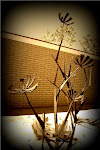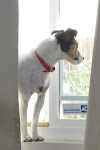For 3 days, I watched the bricklayers shovel sand and cement, turn on the mixer, and make a batch of whatever compound was used for the footing, for stacking the courses of bricks, and for the grouting process. My front yard is a mess, with left-over sand in a pile, stretches of dried concrete here and there, powdered cement sprinkled throughout, and the general debris of bricking a wall.
I watched and thought about the process that has not changed since … pyramids? … and my mind says, “Why is there not a roll of strong adhesive of even thickness, in a variety of natural colors, that can be applied between the courses of bricks?” The bricklayer would start at one end of the course, apply a strip of adhesive to each side of the brick, set the brick in place, and move on to the next course.
We have super adhesives that are used to hold in false teeth, as well as for cementing replacement teeth against the moist gums—and they do a fine job. We have adhesives for construction that stick house numbers to the side of the house and stay there 2 decades later. We have adhesive on the back of Velcro to secure household items during an earthquake. We have adhesives for laying tile, carpet, wallpaper, and many other household applications, but we still make a batch of mud to lay bricks!
I’m not talking about using a semi-liquid compound and an application gun, such as is used in caulking guns. I’m talking about a standardized width of adhesive that looks like strips of brick mortar and can be applied to the top of one brick before another brick is stacked on it. Where the bricks join, a flat, winged bridge piece the width of the brick can be used. In mere minutes, the adhesive is in place, the bricks are firmly tapped into level with a mallot, and there is no mess. Imagine how much quicker and cleaner a wall could be built by using the stripping method.
The process could be so much more environmentally friendly, as well as labor and cost effective, without the detritus of bricklaying as we see it today. We use super adhesives on the rockets we send into space, so why not use it for brick walls, especially those that are primarily boundary markers or provide architectural interest to a property.
If I knew how to develop this idea, I would, especially before I had further bricklaying occur on my property. The end result is so much more appealing than the process.
Subscribe to:
Post Comments (Atom)





1 comment:
My understanding is that mortar can only be used within 2-3 hours of mixing. So I don't think it could be created and used as described here.
As to why use mortar instead of an adhesive? Mortar becomes a very similar structure/compound to the brick or concrete used for the rest of the structure. It has basically the same tensile strength, fire protective abilities, and wear. Depending on the mortar used, it also allows a certain flexibility to the structure that brick or stone may not otherwise have.
An adhesive does not have these features and also may create holes or gaps through which water and air may enter the structure. It also may not wear at the same rate, causing repair concerns sooner than mortar.
All this being said, I have a hard time believing no one else has tried to come up with a "caulk-like" bonding agent that is similar enough to mortar but could be applied in better, even, and faster ways than mortar.
Post a Comment